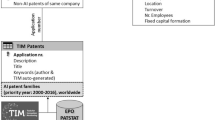Abstract
I use renewal rates and fees to estimate the private value of Finnish patents by patent characteristic. I disaggregate the value estimations by applicant, patent breadth, and technology. Firm patents are 1.5 times more valuable than patents owned by individuals. This holds also when controlling for technology and breadth. There are large differences in values between technologies but in contrast to the usual assumption made in the theoretical literature, broader patents are not necessarily more valuable than narrower ones. Patent value is skewed and therefore the number of patents should be weighted by an index when measuring technological change. I construct this index for Finnish patents and find that renewing a patent one more year signals a 1.5 times more valuable patent.
Similar content being viewed by others
References
Arora, A., Ceccagnioli, M., & Cohen, W. C. (2003). R & D and the patent premium. NBER working paper 9431.
Cohen, W. M., Nelson, R. R., & Walsh, J. P. (2000). Protecting their intellectual assets: Appropriability conditions and why US manufacturing firms patent or not. NBER working paper 7552.
Cooper, A. C., Woo, C. Y., & Dunkelberg, W. (1988). Entrepreneurs’ perceived chance for success. Journal of Business Venturing, 3, 97–108.
Deng, Y. (2005). A dynamic stochastic analysis of international patent application and renewal processes. Southern Methodist University, Department of Economics, working paper 0515.
Deng, Y. (2007). Private value of European patents. European Economic Review, 51, 1785–1812.
Duguet, E., & Iung, N. (1997). R & D investment, patent life and patent value: An econometric analysis at the firm level. Document de Travail de l’INSEE G 9705.
Fikkert, B., & Luthria, M. M. (2000). Intellectual property rights in a developing country: Estimates of the private value of patent protection in India. Mimeo.
Gambardella, A., Harhoff, D., & Verspagen, B. (2006). The value of patents. http://www.alfonsogambardella.it/GHVValueofPatents.pdf Accessed 15 May 2007.
Gilbert, R., & Shapiro, C. (1990). Optimal patent length and breadth. The Rand Journal of Economics, 21, 106–112.
Hall, B. H., Jaffe, A., & Trajtenberg, M. (2005). Market value and patent citations. The Rand Journal of Economics, 36(1), 16–38.
Hall, B. H., & MacGarvie, M. (2006). The private value of software patents. NBER working paper 12195.
Harhoff, D., Scherer, F. M., & Vopel, K. (2003). Exploring the tail of patented invention value distribution. In O. Granstrand (Ed.), Economics, law and intellectual property: Seeking strategies for research and teaching in a developing field. Kluwer Academic Publishers.
Klemperer, P. (1990). How broad should the patent protection be? The Rand Journal of Economics, 21, 113–130.
Koléda, G. (2005). La valeur de la protection des brevets français appreciée par leurs renouvellements. Économie et Prévision, 2(168).
Lanjouw, J. O. (1998). Patent protection in the shadow of infringement: Simulation estimations of patent value. Review of Economics Studies, 65(4).
Lerner, J. (1994). The importance of patent scope: An empirical analysis. The Rand Journal of Economics, 25(2(summer)), 319–333.
Levin, R. C., Klevorick, A. K., Nelson, R. R., Winter, S. G., Gilbert, R., & Griliches, Z. (1987). Appropriating the returns from industrial research and development. Brookings Papers on Economic Activity, 1987(3), 783–831. Special issue on microeconomics.
Machlup (1958). An economic review of the patent system, US Government Printing Office.
Maurseth, P. B. (2005). Lovely but dangerous: The impact of patent citations on patent duration. Economics of Innovation and New Technology, 14(5), 351–374.
Moser, P. (2005). How do patent laws influence innovations? Evidence from 19th-century world’s fairs. American Economic Review, 95(4), 1215–1236.
Nikulainen, T., Pajarinen, M., & Palmberg, C. (2005). Patents and technological change – a review with focus on the fepoci database. ETLA discussion paper 984.
Pakes, A. (1986). Patents as options: Some estimates of the value of holding European patent stocks. Econometrica, 54(4), 755–784.
Pakes, A., & Schankerman, M. (1979). The rate of obsolescence of knowledge, research gestation lags, and the private rate of return to research resources. NBER working paper series 346.
Pakes, A., & Simpson, M. (1989). Patent renewal data, Brookings Papers.
Pinfold, J. F. (2001). The expectations of new business founders: The New Zealand case. Journal of Small Business Management, 39(3), 279–285.
Putnam, J. (1996). The value of international patent protection, PhD thesis, Yale University.
Schankerman, M. (1998). How valuable is patent protection. The Rand Journal of Economics, 29, 77–107.
Schankerman, M., & Pakes, A. (1985). Valuer et obsolescence des brevets:une analyse des statistiques de renouvellement des brevets européens. Revue économique, 36(5), 917–942.
Schankerman, M., & Pakes, A. (1986). Estimates of the value of patent rights in European countries during post-1950 period. Economic Journal, 96, 1052–1076.
Scherer, F. M., & Harhoff, D. (2000). Technology policy for a world of skew-distributed outcomes. Research Policy, 29, 559–566.
Schmookler, J. (1966). Invention and economic growth (pp. 18–56). Harvard University Press, chapter Patent Statistics.
Sullivan, R. (1994). Estimates of the value of patent rights in Great Britain and Ireland, 1852–1876. Economica, 61, 37–58.
Trajtenberg, M. (2001). Innovation in Israel 1968–1997: A comparative analysis using patent data. Research Policy, 30, 363–389.
Warshofsky, F. (1994). The patent wars. The battle to own the world’s technology. New York: Wiley.
Waterson, M. (1990). The economics of product patents. American Economic Review, 80(4), 860–869.
Acknowledgements
I want to thank the Editor of the Journal of Technology Transfer, Otto Toivanen, Laura Arranz-Aperte and two anonymous referees for their helpful comments on this article. I am also thankful to the participants at the AEA conference on Innovations and Intellectual Property Values in Paris in October 2005 and the FDPE Workshop on Microeconomics and Industrial Organization in Helsinki in June 2005. Finally I want to thank the Hanken Foundation for the Young Doctoral Student Grant.
Author information
Authors and Affiliations
Corresponding author
Rights and permissions
About this article
Cite this article
Grönqvist, C. The private value of patents by patent characteristics: evidence from Finland. J Technol Transf 34, 159–168 (2009). https://doi.org/10.1007/s10961-007-9067-6
Published:
Issue Date:
DOI: https://doi.org/10.1007/s10961-007-9067-6




